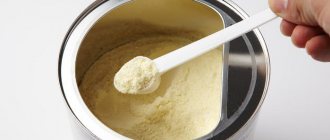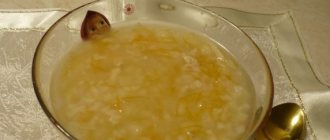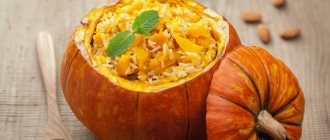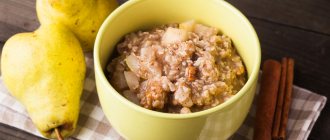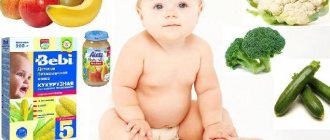A detailed table of complementary feeding can be found in the article “Introduction of complementary feeding during breastfeeding”
The main condition that you must comply with when expanding a child’s diet at 9 months: introduce new foods in tiny portions, starting with ½ - 1 teaspoon, and strictly no more than 1 new product for 2 - 3 days. All this will help in the event of an allergic reaction to clearly identify the allergen.
Read more about allergies in infants.
introduce new products ½ - 1 teaspoon and no more than 1 new product for 2 - 3 days.
If within 2–3 days, after being introduced to a new product, the baby feels great, you can safely continue complementary feeding and increase the dosage, gradually bringing it up to the age norm.
VEGETABLE CREAM SOUP
Age: from 1 year
Ingredients:
- 2 pcs. potatoes
- 400 g pumpkin
- clove of garlic
- 0.5 cups milk
- olive (butter) oil
Preparation:
- Peel and cut the potatoes and pumpkin into small cubes.
- Place the vegetables in a saucepan, cover with water and add a clove of garlic.
- Place the prepared vegetables in a blender bowl, discard the garlic, add a little broth that the potatoes and pumpkin were cooked in and blend until smooth.
- Heat the milk and gradually add it to your puree, whisk until smooth.
- Before serving, you can add croutons to the soup or grate cheese on top.
Baby menu at 9 months
What to feed a 9 month old baby? Let's look at an approximate menu in the diagram below, which shows different variations of the diet for each day of the week for breastfeeding and bottle-feeding.
Breast-feeding
If a mother has the opportunity, then she should not give up breastfeeding, because mother’s milk contains many useful nutrients that are necessary for the baby’s health. Let's create a diet for a 9 month old child for each day of the week.
Monday
- breast milk;
- apple-peach puree, juice without sugar;
- meat broth soup with meatballs, tea, a slice of bread;
- children's cottage cheese, dried fruit compote without sugar;
- breast milk.
Tuesday
- breast milk;
- buckwheat porridge, a piece of butter, tea;
- fish stew with vegetable puree, ½ egg yolk, compote, slice of bread;
- kefir 1%, grated apple, juice without sugar;
- breast milk.
Wednesday
- breast milk;
- pudding, a piece of butter, tea;
- meat broth with chicken, potatoes and carrots, ½ egg yolk, tea, a slice of bread;
- vegetable puree, rosehip drink;
- breast milk.
Thursday
- breast milk;
- millet porridge, egg yolk, juice for children;
- rabbit meatballs with stewed potatoes, butter;
- kefir, plum puree;
- breast milk.
Friday
- breast milk;
- buckwheat porridge, bread, tea;
- chicken cutlets, zucchini with broccoli, rosehip drink;
- cottage cheese pancakes, tea;
- breast milk.
Saturday
- breast milk;
- oatmeal with milk, butter, bread, tea;
- soup with rabbit meat, bread, tea;
- cauliflower with pumpkin, juice for children;
- breast milk.
Sunday
- breast milk;
- buckwheat milk porridge, butter, bread, tea;
- stewed turkey, wheat porridge, bread, tea;
- kefir;
- breast milk.
Artificial feeding
The menu for a 9-month-old baby is practically no different when bottle-fed than when breastfed. Let's look at detailed variations for each day of the week.
Monday
- milk formula;
- rice porridge, butter, bread, tea;
- rabbit broth, zucchini and broccoli puree, bread, tea;
- children's cottage cheese, juice without sugar;
- milk mixture.
Tuesday
- milk formula;
- wheat porridge, ½ egg yolk, tea;
- veal cutlets, cauliflower puree, bread, dried fruit compote;
- fruit puree from apples and pears, juice without sugar;
- milk mixture.
Wednesday
- milk formula;
- fruit puree, ½ egg yolk, tea;
- fish fillet, zucchini puree, bread, juice;
- cottage cheese, juice without sugar;
- milk mixture.
Thursday
- milk formula;
- buckwheat porridge, ½ egg yolk, butter, tea;
- vegetable soup with chicken breast, bread, juice;
- vegetable puree, juice without sugar;
- milk mixture.
Friday
- milk formula;
- rolled oats porridge, ½ egg yolk, juice;
- cream soup of vegetables and chicken, bread, butter, tea;
- cottage cheese casserole, tea;
- milk mixture.
Saturday
- milk formula;
- buckwheat porridge, baby cookies, compote;
- chicken breast meatballs, squash and pumpkin, tea;
- low-fat kefir, juice for children;
- milk mixture.
Sunday
- milk formula;
- fruit and berry puree, baby crackers, tea;
- pumpkin cream soup with turkey, bread, compote;
- cottage cheese, tea;
- milk mixture.
VEGETARIAN CUTLETS
Age: from 1 year
Ingredients:
- 4 eggs
- 1 carrot
- 2 pcs. potatoes
- 1 zucchini
Preparation:
- Boil 1 egg and grate them on a coarse grater.
- Grate the carrots on a fine grater, and the potatoes on a coarse grater and squeeze out the juice.
- Grate the zucchini on a coarse grater and mix with the rest of the vegetables.
- Beat the raw egg with a whisk, mix with the rest of the ingredients and put the mixture in the refrigerator for half an hour.
- Mix the “dough” well, form cutlets with your hands (the juice can be squeezed out) and bake in the oven for 20 minutes at 180 °C.
When to feed
Solid foods take longer to digest and provide energy for a longer period than liquid formula (or breast milk). Therefore, the time between meals should increase. Often, children themselves refuse the next feeding and eat what is offered with appetite within an hour. Therefore, if the first milk feeding was at 6 a.m., the next one will be at 9 a.m., then lunch should be moved from 12 to 1 p.m., approximately plan the afternoon snack for 5 p.m., and leave the evening feeding, the last one, for 9 p.m.
POTATO STARS
Age: from 1 year
Ingredients:
For the test:
- 500 g flour
- 70 ml vegetable oil
- 200 g water
- 0.5 tsp. salt
For filling:
- 1.5 kg potatoes
- 200 g milk
- 70 g butter
- a pinch of salt
Preparation:
- Using a sieve, sift the flour, mix water with vegetable oil and salt, add to the flour and knead the dough.
- Wrap it in cling film and put it in the refrigerator for 40 minutes.
- Prepare the filling. Peel and boil the potatoes. Drain the water, add milk and butter, make a thick puree.
- Take out the dough and roll it out to a thickness of 4-4 mm, using a round mold, cut out circles for future stars.
- Place the filling in the center of each circle and pinch the edges to keep the filling inside.
- Line a thin baking sheet with parchment paper, place potato stars and bake for 20 minutes at 180°C.
How much should a baby eat
When feeding a nine-month-old baby, it is recommended to follow a five-meal plan. Drinking breast milk or formula by 9 months. it is necessary to reduce it to two times, but it is also allowed to supplement with milk or formula after main meals, when the child is not full.
Stick to the diet, every day the baby should eat at approximately the same time, this will have a beneficial effect on his digestion, and it will also be easier for the mother to get used to when the menu for a 9-month-old child is scheduled by the hour.
Make yourself a meal plan for the week and try to stick to it; you can gradually replace some dishes with others. With this plan, it will be convenient for you to control your baby’s diet so that his nutrition is balanced.
Meals should be arranged 4 hours apart. But if the baby requires more food after the main meal, then you can make him a snack of juice and cookies. The optimal portion of the main meal at this age is about half the volume of a tea cup.
Remember that nutrition is tailored individually, specifically for a specific person. If your friend’s child eats in one mode, and yours in another, this does not mean that one of you is feeding the child incorrectly.
Each person’s body is special, what some children like, others don’t like. You can also adjust the timing of meals, but do not overdo it; after all, the baby must develop a daily routine and diet, otherwise it will have a bad effect on his well-being. Don’t force him to eat - if he doesn’t eat now, he will eat in a couple of hours.
FILLET BAKED WITH PEACHES AND PLUMS
Age: from 8 months
Ingredients:
- 300 g chicken fillet (you can also use turkey)
- 4 peaches (nectarines)
- 3 plums
- honey (after 1 year)
Preparation:
- Grease a baking dish with vegetable oil.
- Lightly salt the chicken fillet and place in the pan, cover with foil on top. Cook in the oven for 20-25 minutes.
- Wash the fruits, remove the seeds and cut into quarters, place with the meat and bake without foil for another 15 minutes, pouring fruit juice over the dish to make it juicy.
- Add a little honey to the finished dish (after 1 year), cover the top with foil and let stand for another 10 minutes.
- Meat with fruit is a very unusual combination that kids love! In addition, when cooking meat with fruit, iron is better absorbed from it.
Basic feeding rules
The baby eats up to 6 times a day every 3-4 hours. The first and last meal is always breast milk or an adapted formula. During other meals, the child is offered a menu made up of dishes from the “adult” table.
Food is served in special children's dishes - bright and unbreakable. Cheerful pictures and images of familiar fairy-tale characters will introduce holiday elements into your diet.
While feeding, tell your baby funny stories, play airplane, and sing funny songs.
Is your baby growing by leaps and bounds?
Menu for a 10 month old baby.
PUMPKIN SOUP
Age: from 1 year
Ingredients:
- 500 g pumpkin
- 1 onion
- 1 carrot
- 1 clove of garlic
- 4 tbsp. l. milk
Preparation:
- Chop the garlic and onion, grate the carrots on a coarse grater, peel the pumpkin and cut into cubes.
- Simmer the vegetables without oil for about 5 minutes until the onion is soft. Add the pumpkin, cover with chicken broth or boiling water and cook until the pumpkin is cooked.
- Place the stewed vegetables in a blender bowl and puree smoothly. The thickness of the soup can be adjusted by adding a little boiling water or broth.
Milk buckwheat porridge
Ingredients:
- buckwheat (or flour) – 50 grams;
- milk – 400 milliliters;
- butter - a third of a teaspoon;
- salt, sugar - you can use a pinch, you can not use it at all.
The milk goes to the stove. When it boils, add buckwheat or flour to it. If flour is used, it must first be mixed with a small amount of milk. Bring to a boil, reduce heat to low, cover and cook until done for about 20 minutes. At the end of cooking, add butter, if necessary, you can add salt and sugar to the porridge.
EGG CUTLETS
Age: from 1 year
Ingredients:
- 5 hard-boiled eggs
- 1 raw egg
- breadcrumbs (potato flakes)
- finely chopped greens or a little onion (squeeze through a garlic press)
- grated cheese (optional)
Preparation:
- Grate the eggs, add a raw egg, mix everything well with a fork.
- Add the remaining ingredients, mix and refrigerate for 15-20 minutes. Form into cutlets and roll in breading.
- Bake on baking paper at 160°C for approximately 15-20 minutes until golden brown.
Complementary feeding norms with soups for an eight-month-old baby
Is it necessary to walk with your child every day - why is it necessary?
Any new products are introduced into the baby’s diet gradually. Dr. Komarovsky does not recommend introducing a child to unfamiliar dishes during illness, a few days before preventive vaccinations and three days after them. If the baby refuses to eat or does it with great reluctance, it is not recommended to insist. It's better to repeat the experiment later.
If you serve your child soup on a bright plate, he will eat with great pleasure
Serving Size
If you prepare soups from products that are already familiar to your child, you can start with full portions - 100-150 ml. If the first dish contains a new ingredient, for example pumpkin, it’s not worth the risk. First, it makes sense to test on 1-2 spoons how the baby and his body will respond to the innovation
Important! If the child has already learned to chew, the food can be finely chopped, and if not, cook pureed soups.
Frequency of complementary feeding with soup
It is best to feed eight-month-old babies soup once a day - during lunch. Some parents give their baby the first meal in the evening. Both options have a right to exist; the frequency of complementary feeding with soups should be calculated individually.
Making delicious and healthy soup is easy.
Most experts have not yet come to a consensus as to exactly what age to start feeding babies liquid meals. This is not always the average 8 months. Some pediatricians are confident that the soup will not harm the baby even at six months, others strongly recommend waiting until the child reaches 11 months or even a year. The only thing that all the pros agree on is that breastfed babies need complementary feeding with soups later than those babies who eat artificial formula.
PASTA BAKED IN THE OVEN WITH BROCCOLI
Age: from 1 year
Ingredients:
- pasta (not spaghetti) 250 g
- broccoli 150-200 g
- milk 1 liter
- flour 6 tbsp. l with a slide
- butter 25 g
- grated cheese
Preparation:
- Bring the water to a boil, add a little salt and boil the broccoli for 2 minutes.
- In the water in which you cooked the broccoli, boil the pasta for 2-3 minutes.
- Transfer the pasta and broccoli to a baking dish, add the grated cheese and stir to combine.
- Prepare bechamel sauce: pour half a liter of milk into a pan, preferably one with a Teflon coating, put butter in it, add a little salt and heat over low heat, the butter should melt, but the milk should not boil.
- Mix the remaining half liter with flour.
- When the butter in the pan has melted, gradually add milk and flour to the pan and stir constantly, it will soon begin to thicken, if it does not thicken, you need to increase the heat. The finished bechamel turns out like liquid sour cream.
- Pour bechamel sauce over the pasta, sprinkle with grated cheese and place in an oven preheated to 200°C for 15-20 minutes.
Fish dishes
Hake with new potatoes
Fish supplies the child's body with chromium, which regulates metabolic processes, as well as vanadium, which promotes the mineralization of tooth enamel.
| Required Ingredients | Preparation |
| It is necessary to heat the oven to 200°C, wrap the fish in foil along with lemon, dill and bake for 8-10 minutes. During this time, you should boil the potatoes (preferably steamed). It is important to remove the skin from cooked hake and remove all the bones. Potatoes and fish are mashed with the addition of butter on the tip of a knife, as well as water or milk to make it even more tender. |
Boiled fish meatballs
Fish has an ideal amino acid composition. It should be included in the baby’s menu starting from 8 months of age. It is perfectly absorbed by the child's body, but there is a minus: fish can cause food allergies.
Therefore, nutritionists recommend that parents give children under one year of age, once a week, instead of meat, “non-allergenic” fish: hake, cod.
To prepare this dish, we recommend using cod, as it contains a large amount of protein, iodine, vitamin B12, the amino acid tyrosine and less than 1% fat.
Iodine “feeds” the thyroid gland, vitamin B12 fights the negative effects of stress (don’t forget that sometimes a child has to be shown to doctors, which can really scare him), thyrotine stimulates brain function.
| Required Ingredients | Preparation |
| It is necessary to mince or grind the fish fillet and onion in a blender, then add the egg, flour, and salt. You need to roll the minced meat into balls, put them in boiling water and cook for 10 minutes. Boiled rice mixed with boiled grated carrots is ideal as a side dish for ready-made meatballs. |
A little more and your baby will celebrate his first birthday. Therefore, it will be necessary to add variety to his diet. We offer you delicious and healthy recipes for babies from 1 year old.
Are you concerned about the question of when children start walking, do they need to be stimulated and how to do it correctly? Then this is the place for you.
What do you need to know about Staphylococcus aureus, and what danger does it pose to the child’s body? We advise you to familiarize yourself with our material.
How to diversify your child’s fitball activities? Check out the set of exercises for children from 10 months.
POTATO PANCAKES
Age: from 1 year
Ingredients:
- 6 medium potatoes
- 2 eggs
- 2 tbsp flour
- a pinch of salt
Preparation:
- Peel the potatoes, grate them on a coarse grater and squeeze them.
- Beat 2 eggs with a fork and mix with potatoes, add flour, salt, mix.
- Spoon onto a baking sheet lined with parchment and bake until golden brown at 170°C.
Breakfast
Millet soufflé
A proper breakfast is the key to your baby’s good mood and well-being.
Why not start it with porridge - the healthiest dish?
Moreover, millet porridge is not only healthy, but also very tasty.
| Required Ingredients | Preparation |
| It is necessary to scald the millet with boiling water and drain the water (this will remove any possible bitterness). Then pour a glass of boiling milk over the millet, add sugar and cook under the lid until tender, seasoning with vanillin crystals. The porridge is whipped in a blender and applesauce is added to it. If desired and if available, you can add any other fruit or berry puree to the porridge. |
Apple-carrot puree
Apples, containing pectin, malic and tartaric acids, many vitamins and the antioxidant quercetin, normalize digestion and strengthen the immune system.
Carrots contain carotene, fluorine, copper, zinc, iodine, magnesium, copper and also many vitamins.
In addition, fresh apples and carrots perfectly clean the baby’s first teeth (if they already have them) and gums. Therefore, it is not for nothing that popular wisdom says: “He who often gnaws apples and carrots laughs well.”
| Required Ingredients | Preparation |
| You need to peel the apple, cut out the core, peel the carrots and grind together with the apple in a blender to a puree consistency. Then add a little boiled milk and sugar to taste to the puree, and mix everything thoroughly. You can crumble some cookies into the puree. |
CHICKEN SOUP
Age: from 1 year
Ingredients:
- two chicken thighs
- two bell red peppers
- 3-4 stalks of celery
- a glass of buckwheat
- parsley
- optional: lemon juice or soy sauce
Preparation:
- Wash the chicken, remove skin and fat, boil until tender in 2-3 broth. When cooking, you can add carrots or garlic to the broth for flavor, and then remove them. Cool the meat and chop into small pieces.
- Chop the vegetables and boil in broth until tender.
- Pre-soak the buckwheat overnight in cold water, rinse and add along with parsley to the pan 10-15 minutes before the soup is ready, add a little salt (optional)
- Add chopped chicken to the finished soup.
- Already in the plate, you can add salt and pepper to the soup and add soy sauce. For kids, you can add a little lemon juice (a couple of drops is enough).
Let's start doing magic in the kitchen
To whet the appetite of children, as well as supplement the main dishes with vitamins and many useful substances, it is necessary to include soups, vegetable and fruit purees, meat, fish and vegetable dishes in the children's menu every day.
It wouldn’t hurt to make it a rule to gather around the table with the whole family (at least once a day).
This is a great opportunity to network and build trust. And it doesn’t matter at all that the baby is not yet able to eat at a common table and yet speak, but eats in his highchair and only “chirps.”
It is from such an early age that it is necessary to instill a culture of nutrition and behavior at the table in the younger generation.
At the same time, problems with stool, namely constipation and diarrhea, do occur and cause many problems for both parents and the children themselves.
What to do if your child is constipated? Check out useful information.
EGG AND ZUCCHIN CUTLETS
Age: after 1 year
Ingredients:
- 5 eggs
- 1/2 medium zucchini
- 50 g grated cheese
Preparation:
- Boil 4 eggs, peel and grate on a coarse grater.
- Wash the zucchini and grate it on a fine grater.
- Mix the boiled eggs with the raw mixture using a fork, add the zucchini and cheese.
- Spoon onto parchment paper and bake until golden brown at 160°C.
Veal puree soup with vegetables
Ingredients:
- veal – 60 grams;
- potatoes – 50 grams;
- carrots – 40 grams;
- onion – 10 grams;
- cauliflower – 60 grams;
- vegetable oil - a third of a teaspoon;
- greens - to taste.
The veal must be cut into pieces, pour cold water and boil until half cooked. Then add vegetables one by one, first carrots, then onions, potatoes, cauliflower. When everything is ready, add oil and turn off. When serving, you need to add greens.
No matter how long the meat is cooked, it remains a little tough for the child. Therefore, it is better to grind the soup using a blender or crank only the meat and grind the vegetables.
TURKEY BALLS WITH SPINACH
Age: from 9 months
Ingredients:
- 500 g minced turkey
- 200 g spinach
Preparation:
- Rinse the spinach well and boil in boiling water for 15 minutes, cool slightly.
- Mix the minced meat with the spinach and knead well.
- Form balls and bake on parchment for 15-20 minutes at 160-180 °C.
What should not be included in a baby's menu at 9 months?
We have figured out what to feed a baby at 9 months, now we will look at foods that you should avoid. When a baby is less than 1 year old, you should not give him cow's milk, since it contains a large amount of calcium, which the kidneys, liver, stomach and intestines may not be able to cope with.
Also limit the amount of spices and do not add salt to your dishes. Refrain from sugar, choose children's juices, having carefully studied the composition; packaged juice “for adults” is not allowed for a baby at this age. The same applies to foods to which the baby has an allergic reaction; they should be excluded from the diet.
CUTLETS WITH ZUCCHIN AND CARROTS
Age: from 8 months
Ingredients:
- 500 g minced white meat (chicken/turkey)
- 1 small zucchini
- 1 medium carrot
Preparation:
- Grate the vegetables on a fine grater. Mix the minced meat with vegetables and knead well.
- If you are cooking for the whole family, you can add a little salt, literally at the tip of a teaspoon.
- Form the cutlets and place them in a baking dish lined with baking paper in an oven preheated to 180°C.
- Cook the cutlets for 15-20 minutes until browned.
Child nutrition: new foods in the diet
Mother's milk during the period of 9 - 10 months is still an integral part of the daily menu, since it contains the amount of nutrients necessary for the baby's body. It is understood that the main complementary foods have already been introduced earlier; by 9 months the baby already knows cereals, juices, and meat products. During this period, it is important to expand the diet with new dishes, combinations, and also change the consistency of dishes, switch to food chopped into small or large cubes.
At 9 months The baby’s diet should contain the required amount of CBJU, as well as food rich in vitamins and microelements.
List of products recommended for consumption by a baby at the age of nine months:
- baby purees from vegetables and fruits;
- children's juices and compotes from dried fruits without added sugar;
- lean meat products (chicken, rabbit, turkey);
- boneless fish fillet;
- porridge;
- egg yolk;
- children's cottage cheese;
- low-fat kefir;
- specialized children's snacks.
WHO (World Health Organization) recommends that parents include products from the above list in the menu by the age of 9 months. But if they have not been introduced, then be sure to start introducing the innovations to your baby. It is recommended to introduce one product once a week to control how the baby’s body perceives this or that new product.
It is also recommended to give a new dish to the baby at the beginning of the day, perhaps for lunch, so that until the evening the parent can observe the child’s well-being and draw a conclusion regarding the new element of complementary feeding. If you give your baby a new dish in the evening, but it doesn’t suit him, then the baby will have an uncomfortable sleep, and even more so the mother. During the day, food is digested more easily.
If you are not allergic to a new dish, then gradually include it in your diet, increasing the portion. If a child is allergic to an innovation, then it is worth consulting with a pediatrician, limiting the consumption of this product and finding an alternative.
BAKED APPLE WITH FILLING
Age: from 7 months
Ingredients:
- 2 apples (for babies under 9 months it is better to choose yellow ones)
- 4 prunes, pre-soaked for a couple of hours
Preparation:
- Wash the apples, wipe with a paper towel, cut off the cap and cut out the middle.
- Place prunes inside the apples, add 3 teaspoons of water, cover with caps.
- Bake at 150 °C for approximately 30-40 minutes
- You can pinch off small pieces of fruit for your baby or puree them.
Daily diet
In no case is the nutrition of a 9-month-old child built intuitively. It is necessary to follow a meal schedule. It is recommended to organize the nutrition of a 9-month-old baby in 5 meals, 2 of which will consist of liquid food, and 3 of solid food; liquid meals should be the first and last of the day, because solid food is digested and absorbed more slowly, which allows the body to save energy.
Do not force feed your baby; if he refuses food, then wait a couple of hours and feed him later.
Breastfed
When a child is breastfed, a special bond is created between mother and baby. But mother's milk at this age does not form the basis of the diet, since it does not contain enough of the elements that the child needs.
It is advisable that breast milk at the age of 9 months should be the baby’s first breakfast immediately after waking up, and the second time breast milk can be fed before bedtime, so as not to overload the baby’s body with solid food before bedtime.
Let's look at a child's nutrition at 9 months, diet, regimen and menu:
- after waking up (6:00): breast milk;
- breakfast (10:00): rice porridge with milk, pear puree, tea;
- lunch (14:00): broth from boiled chicken breast with vegetables, a slice of bread;
- dinner (18:00): fish balls, cauliflower puree, children's juice without sugar;
- second dinner (20:00, before bedtime): breast milk.
If these meals are not enough for the child, then add snacks consisting of compote, children's cookies or crackers; you can also increase the weight of the serving from the main meal.
Artificially fed
When bottle-fed, it is recommended to feed in the same mode as when breast-fed. The baby should eat formula milk in the morning after waking up and in the evening before bed, and the rest of the meals should consist of solid foods.
Approximate daily diet:
- after waking up (6:00): infant formula;
- breakfast (10:00): cottage cheese, grated pear, compote without sugar;
- lunch (14:00): turkey meat stew with potatoes and carrots, a slice of bread, tea;
- dinner (18:00): chicken meatballs, stewed vegetables (zucchini + cauliflower), tea;
- second dinner (20:00, before bedtime): infant formula.
BANANA CUPCAKES
Age: from 1 year
Ingredients:
- 1 banana
- 1 egg
- 1 pear
- 100 g yogurt
- 60 g wheat flour
- 60 g rice flour
- 1/2 teaspoon baking soda
Yield: 8 pieces
Preparation:
- Mix the egg with yogurt.
- Peel the banana and mash with a fork. Peel the pear, remove the core and cut into small cubes. Add fruit to the dough, then soda, mix.
- Carefully add flour, stir and distribute the dough into the molds, filling a little higher than 2/3.
- If you cook in silicone molds, you do not need to grease them with oil. Bake in a preheated oven at 180°C for 30-35 minutes.
Rice flour can be replaced with oatmeal, and yogurt with sourdough from a dairy kitchen.
Source
Dietary recommendations
When breastfeeding or bottle-feeding, every mother should know when and at what time the baby should be fed. Meal times are selected individually.
If your baby used to eat while sitting on his parent’s lap, it’s time to move him to a high chair.
It is recommended to give him a piece of bread or a spoon in his palm, to help the child understand how to eat bread and use a spoon. At the same time, nutrition should not be forced.
It’s also time to offer drinks in a cup, and it’s better to refuse a bottle with a nipple.
Carrot puree with chicken and pepper (from 10 months)
Source: Freepik
Ingredients:
- Carrots – 175 g
- Yellow pepper – 175 g
- Chicken fillet – 150 g
- Onion – 100 g
- Olive oil
How to cook?
Peel and cut carrots, peppers and onions into cubes, then boil in 300 ml. water. In a separate pan, boil the chicken fillet, previously cut into small pieces. Place the prepared vegetables and chicken meat in a separate container and grind using a blender. Add olive oil to the finished puree and serve to your baby.
